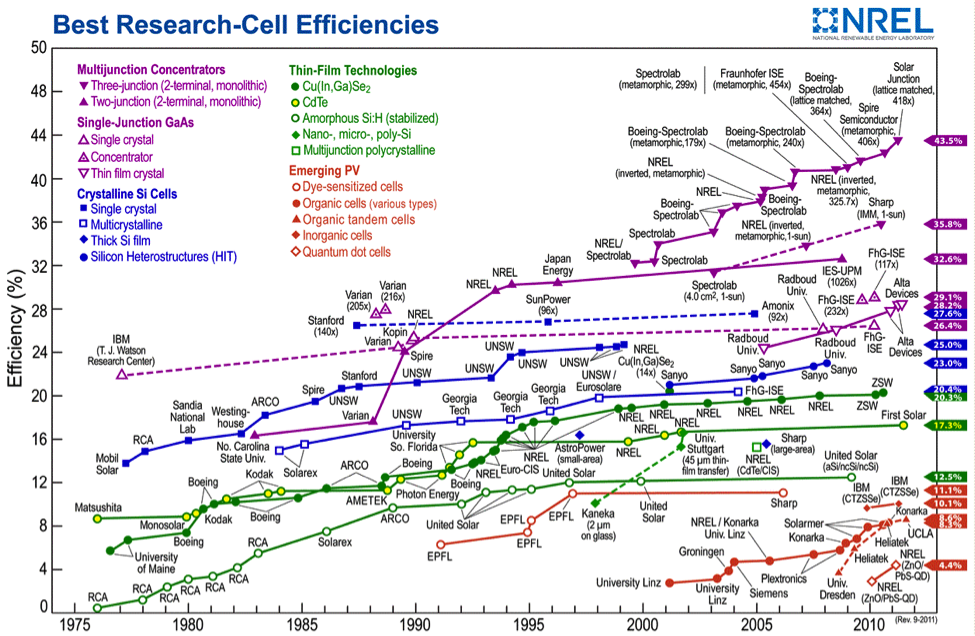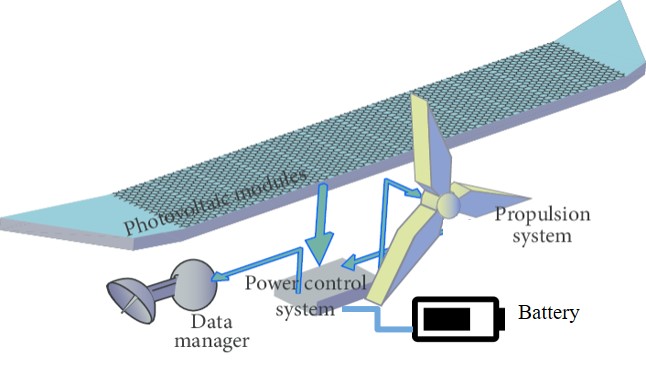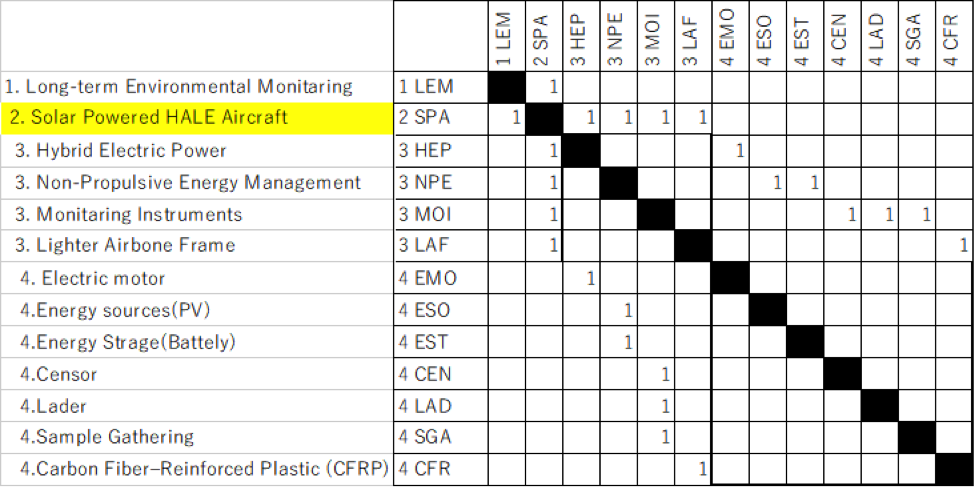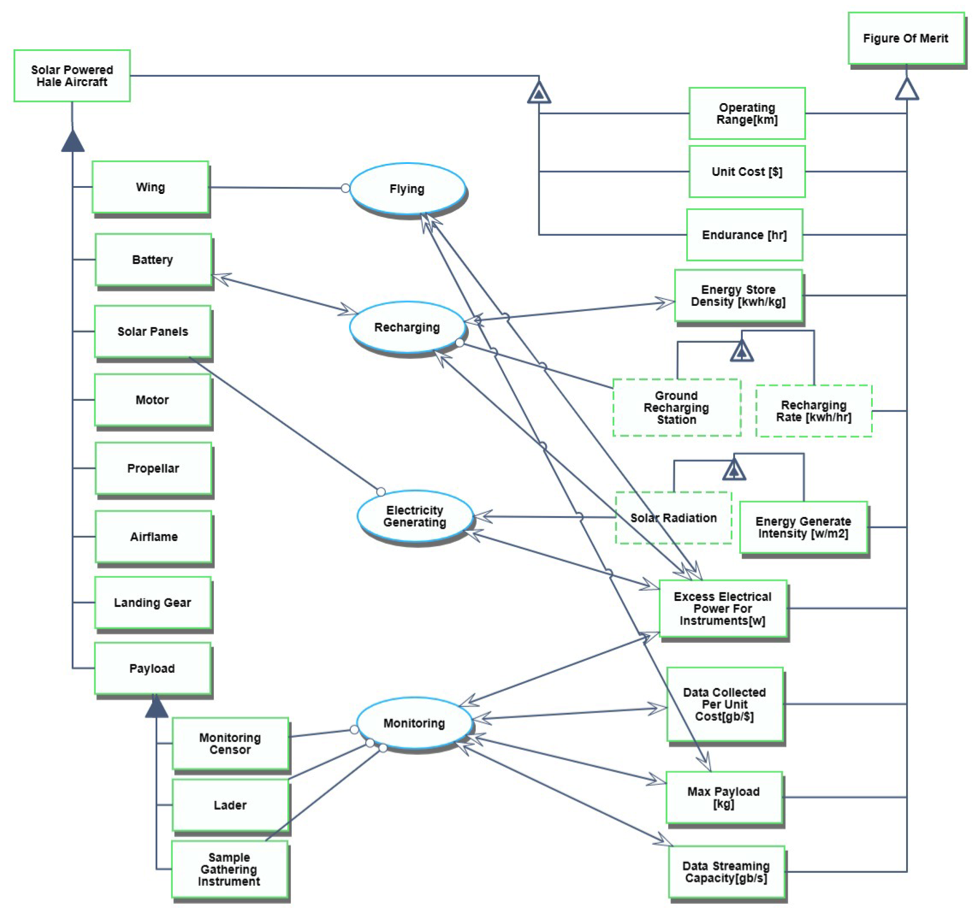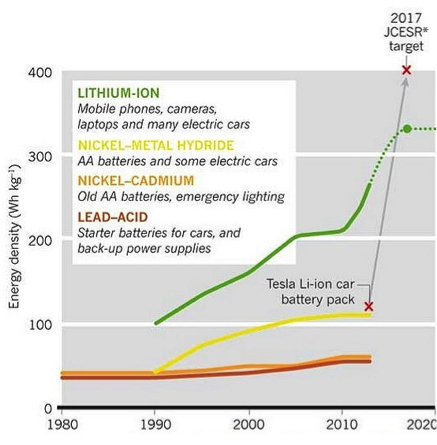Difference between revisions of "Solar-Powered HALE Aircraft, by Naoki Kobayashi, Alex Kunycky, Yuya Makino"
| Line 82: | Line 82: | ||
Energy Density (Storage):<br /> | Energy Density (Storage):<br /> | ||
From 1975 to 2014, its FOM changed from 45 to 240. So its annual rate of improvement is 4.4%.(45*1.044^39=241) | From 1975 to 2014, its FOM changed from 45 to 240. So its annual rate of improvement is 4.4%.(45*1.044^39=241) | ||
[[File:BTFIG.png]] | [[File:BTFIG.png]] | ||
Revision as of 16:50, 1 October 2020
Roadmap Overview
Solar-electric HALE aircraft are lightweight, high aspect ratio planes that generate electricity using photovoltaic cells on the lifting surfaces. This aircraft will be deployed for month-long missions, as a closer alternative to satellite observation of the earth’s changing climate, so the aircraft must generate and store excess electricity during the day to stay aloft at night. The payload will include instrumentation only; the electrical “payload” required to run the instruments will be more critical than their relatively-low mass. The aircraft will enable climate scientists to make precise, prolonged measurements anywhere in the world, to inform and build climate models as the atmosphere continues to warm.
Design Structure Matrix (DSM) Allocation
Roadmap Model using OPM
OPL:
Solar Powered Hale Aircraft is informatical and systemic.
Wing is physical and systemic.
Battery is physical and systemic.
Motor is physical and systemic.
Airflame is physical and systemic.
Solar Panels is physical and systemic.
Payload is physical and systemic.
Propellar is physical and systemic.
Landing Gear is physical and systemic.
Monitoring Censor is physical and systemic.
Lader is physical and systemic.
Sample Gathering Instrument is physical and systemic.
Solar Radiation of Energy Generate Intensity is physical and environmental.
Ground Recharging Station of Recharging Rate is physical and environmental.
Figure Of Merit is physical and systemic.
Energy Store Density is physical and systemic.
Energy Generate Intensity is physical and systemic.
Max Payload is physical and systemic.
Excess Electrical Power For Instruments is physical and systemic.
Recharging Rate is informatical and environmental.
Unit Cost of Solar Powered Hale Aircraft is physical and systemic.
Endurance of Solar Powered Hale Aircraft is physical and systemic.
Data Collected Per Unit Cost is physical and systemic.
Operating Range of Solar Powered Hale Aircraft is physical and systemic.
Data Streaming Capacity is physical and systemic.
Solar Powered Hale Aircraft consists of Airflame, Battery, Landing Gear, Motor, Payload,
Propellar, Solar Panels, and Wing.
Payload consists of Lader, Monitoring Censor, and Sample Gathering Instrument.
Data Collected Per Unit Cost, Data Streaming Capacity, Endurance, Energy Generate Intensity,
Energy Store Density, Excess Electrical Power For Instruments, Max Payload,
Operating Range, Recharging Rate, and Unit Cost are Figure Of Merit.
Energy Generate Intensity exhibits Solar Radiation.
Recharging Rate exhibits Ground Recharging Station.
Solar Powered Hale Aircraft exhibits Endurance, Operating Range, and Unit Cost.
Flying is physical and systemic.
Flying requires Wing.
Flying affects Excess Electrical Power For Instruments and Max Payload.
Recharging is physical and systemic.
Recharging requires Ground Recharging Station of Recharging Rate.
Recharging affects Battery, Energy Store Density, and Excess Electrical Power For Instruments.
Electricity Generating is physical and systemic.
Electricity Generating requires Solar Panels.
Electricity Generating affects Excess Electrical Power For Instruments.
Electricity Generating consumes Solar Radiation of Energy Generate Intensity.
Monitoring is physical and systemic.
Monitoring requires Lader, Monitoring Censor, and Sample Gathering Instrument.
Monitoring affects Data Collected Per Unit Cost, Data Streaming Capacity,
Excess Electrical Power For Instruments, and Max Payload.
Figures of Merit (FOMs)
The table below shows a list of key FOMs by which HALE can be assessed.
| FOM name | Units | Description |
|---|---|---|
| Endurance | km | Distance that can be traveled in an operation |
| Energy Density (Storage) | kWh/kg | Amount of energy that can be stored per unit volume |
| Power Density (Generation) | kW/M^2 | Amount of energy that can be generated per unit area |
Endurance:
With the exception of ZEPHYR, no progress was made on range, as the main solar plane projects appear to be aimed at expanding payloads.
Energy Density (Storage):
From 1975 to 2014, its FOM changed from 45 to 240. So its annual rate of improvement is 4.4%.(45*1.044^39=241)
Power Density (Generation):
The conversion efficiency reached 46% in 2013, up from 1% in 1976; since 45% progress was made over 37 years, the average growth rate was 1.2%.
